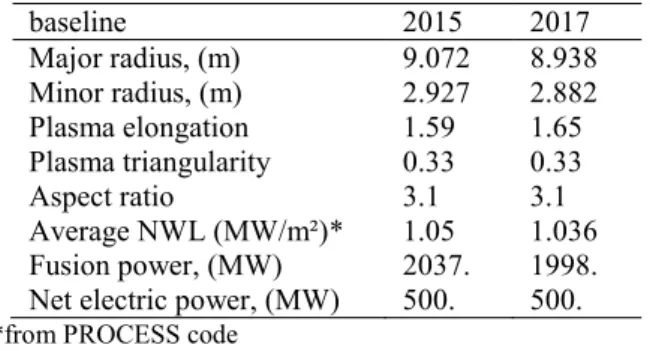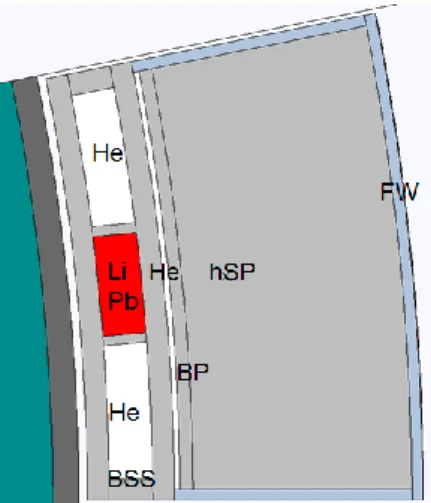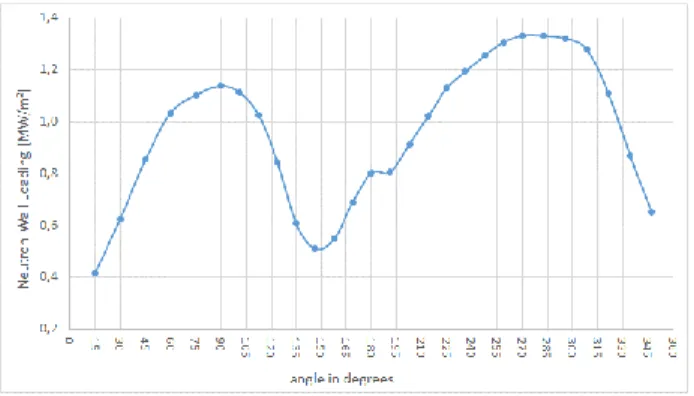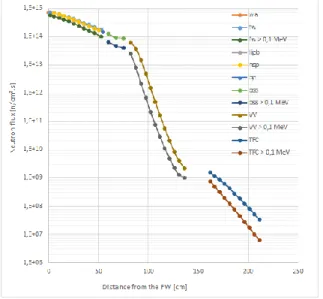HAL Id: cea-02339714
https://hal-cea.archives-ouvertes.fr/cea-02339714
Submitted on 20 Nov 2019
HAL is a multi-disciplinary open access
archive for the deposit and dissemination of
sci-entific research documents, whether they are
pub-lished or not. The documents may come from
teaching and research institutions in France or
abroad, or from public or private research centers.
L’archive ouverte pluridisciplinaire HAL, est
destinée au dépôt et à la diffusion de documents
scientifiques de niveau recherche, publiés ou non,
émanant des établissements d’enseignement et de
recherche français ou étrangers, des laboratoires
publics ou privés.
Nuclear Analysis of the HCLL ”Advanced-Plus”
Breeding Blanket with Single Module Segment Structure
Jean-Charles Jaboulay, Giacomo Aiello, Julien Aubert, Rémi Boullon
To cite this version:
Jean-Charles Jaboulay, Giacomo Aiello, Julien Aubert, Rémi Boullon. Nuclear Analysis of the HCLL
”Advanced-Plus” Breeding Blanket with Single Module Segment Structure. Fusion Engineering and
Design, Elsevier, 2018, 146 (Part A), pp.162-167. �cea-02339714�
_______________________________________________________________________________ author’s email: jean-charles.jaboulay@cea.fr
Nuclear Analysis of the HCLL “Advanced-Plus” Breeding Blanket with
Single Module Segment Structure
Jean-Charles Jaboulay
a, Giacomo Aiello
a, Julien Aubert
a, Rémi Boullon
a aDEN-DM2S, CEA, Université Paris-Saclay, F-91191, Gif-Sur-Yvette, FranceThis paper presents the nuclear analysis carried out with the TRIPOLI-4® Monte-Carlo code for the Helium
Cooled Lithium Lead (HCLL) “Advanced-Plus” breeding blanket design using the Single Module Segment (SMS) option in the European DEMO 2017 baseline. Compared to the previous one, this baseline is characterized by a radial outboard breeding blanket thickness reduction of 30 cm. Previous study has quantified its impact on Tritium Breeding Ratio (TBR reduction up to -0.08). This major constraint lead to the need of SMS solution development with HCLL “Advanced-Plus” design to reduce the amount of steel in the breeding blanket for TBR improvement. HCLL “Advanced-Plus” design is currently developed with the aim to improve the TBR. The main nuclear quantities: neutron wall loading, TBR, nuclear heating, neutron flux, displacement damage and helium production are reported and discussed.
Keywords: DEMO, HCLL, SMS, breeder, blanket, fusion, neutronic.
1. Introduction
In the framework of the Horizon H2020 program, the European consortium EUROfusion [1] develops a conceptual design of a fusion power demonstrator (DEMO) with the capability of generating several hundred MW of net electricity and operating with a closed fuel-cycle by 2050. The Breeding Blanket (BB) is one of the key components of DEMO. It must ensure tritium self-sufficiency and heat removal functions. In this framework, CEA, with the support of Wigner-CR and IPP-CR, is in charge of the design of the Helium Cooled Lithium Lead (HCLL) blanket [2]. It uses liquid lithium lead eutectic as tritium breeder and neutron multiplier and helium gas as coolant for both the Eurofer structure and the breeder.
To have more margin in Tritium Breeding Ratio (TBR), the reference HCLL BB design has moved from a TBM-like concept, based on the Test Blanket Module for ITER, to a so-called “advanced-plus” concept [3]. It is characterized by the absence of vertical stiffening plates allowing a reduction to the amount of steel.
The current DEMO 2017 baseline is characterized by a reduced radial outboard BB thickness of 30 cm for a better plasma vertical stability. Previous study [4] has quantified its impact on TBR, which is decreased up to -0.08, from 1.15 to 1.07, in this condition TBR criteria of 1.10 is not fulfilled. To overcome this major issue the Single Module Segment
(
SMS) solution was investigated. This promising design option (SMS) improves the TBR by +0.07 [4] compared to Multi-Module Segment (MMS). The HCLL “advanced-plus” closing caps of each module are very thick (7.5 cm), SMS drastically reduce the number of caps.This article presents nuclear analysis carried out with the TRIPOLI-4® Monte-Carlo (MC) code [5] and the
JEFF-3.2 nuclear data [6] for the HCLL “Advanced-Plus” breeding blanket design using the SMS option in
the current European DEMO 2017 baseline. The main nuclear quantities: Neutron Wall Loading (NWL), TBR, Nuclear Heating (NH), neutron flux, displacement damage and helium production are reported and discussed.
2. HCLL DEMO 2017 baseline model
In 2017 a new DEMO baseline was issued. The main reactor parameters are presented in Table 1 for the new and the former baseline. Additionally, the outboard BB thickness is reduced by 30 cm, the shape of the inboard BB is very different and its radial thickness is increased by 6 cm.
Table 1. Main DEMO 2015 and 2017 baseline parameters.
baseline 2015 2017 Major radius, (m) Minor radius, (m) Plasma elongation Plasma triangularity Aspect ratio Average NWL (MW/m²)* Fusion power, (MW) Net electric power, (MW)
9.072 2.927 1.59 0.33 3.1 1.05 2037. 500. 8.938 2.882 1.65 0.33 3.1 1.036 1998. 500.
*from PROCESS code
A DEMO 2017 generic CAD model was developed at KIT, both MCNP and TRIPOLI models were generated using McCad's CAD to CSG (Constructive Solid Geometry) conversion capabilities [7]. Some corrections were made in the TRIPOLI model that mainly concern cones surface definition difference between TRIPOLI and MCNP. In the 2017 baseline there are 16 sectors and TF coils. Only one sector of the machine is described in the model, the other sectors are considered identical. A sector is made of 2 inboard segments (IbS) and 3 outboard segments (ObS). The sector studied is also considered with a symmetry that enable the description of only one segment at inboard
and one segment and a half at outboard (11.25° model). Reflective boundary condition are used to model these symmetries. Figure 1 shows the different BB segment at inboard and outboard. The shape of the central outboard segment is not the same as the lateral ones, for remote handling purpose. In the whole machine there are 32 inboard segments, 32 lateral outboard segments and 16 central outboard segments.
Fig. 1. Radial – toroidal cut of the DEMO 2017 half sector (11.25°); #1 inboard BB segment, #2 outboard BB lateral
segment, #3 outboard central segment
BB cells are empty in the generic model. First wall (FW), back plate (BP), caps and back supporting structures (BSS) were developed using the surfaces of the generic model BB banana. For instance, FW is built with the front surface of the generic BB and a new surface defined as the front BB surface translation of the thickness of the FW. The internal breeding zone structure is made of a collection of lithium-lead layers and horizontal stiffening plates (hSP). hSP normal vector is tangent to the FW surface in other words hSP are perpendicular to the FW surface (Figure 2). The distance between adjacent hSP at the FW surface is 3.54 cm. A Python tool was written to generate the BB structure.
Fig. 2 Radial – poloidal cut of the upper part of inboard segment (color legend: LiPb – red, eurofer – gray, VV 1st layer
– deepgray, VV 2nd layer – darkcyan). (For interpretation of the
references to colour in this figure legend, the reader is referred to the web version of this article.)
Last year, some modifications in HCLL “Advanced-Plus” BB were implemented by the designers. These modifications concern mainly the internal manifold region. In the previous design, one helium manifold and one lithium-lead manifold were employed and a thick plate (3 cm) separates them. Tie Rod (TR) were used to stiffen the BSS – Breeding Zone (BZ) assembly. A back
plate BP closes the BZ (FW – caps assembly). The current design is simplified, Li-Pb manifold, tie rods and BZ closing plate are removed. Figure 3 shows the HCLL “Advanced-Plus” design of 2017. The main characteristics (structures thickness and compositions) of the HCLL “Advanced-Plus” BB are given in Table 2.
Fig. 3. Radial – toroidal cut of the inboard segment; BZ is closed by the FW, caps and BP, the internal He manifold behind the BP supply He in hSP (He comes from the FW output); BSS contains two helium manifolds which supply the
FW and one LiPb manifold which directly supply the BZ Table 2. HCLL “Advanced-Plus” breeding blanket
characteristics
Name Thichness
(cm) Composition Breeding Zone+Internal He manifold
W armor 0.2 100% W FW 2.5 71% Eurofer - 29% Hec) Caps 7.5 b) 97% Eurofer - 3% Hec) hSP 0.5b) 60% Eurofer - 40% Hec) LiPb 3.54 b) 100% LiPbd) BP between the BZ and the He manifold 3 100% Eurofer He manifold 1.3 100% He
Back supporting structure BSS total thickness inboard 20 - BSS total thickness outboard 35 - BSS wall and
side wall 5.0 100% Eurofer
He LiPb
separator 2.25
a) 100% Eurofer
LiPb inboard 22.964a) 100% LiPbd)
LiPb Outboard 30.1 a) 100% LiPbd)
Thickness is given in radial direction except a) in toroidal direction and b) in poloidal direction. c) eurofer helium homogenization is considered (helium channel are not represented) eurofer material density is modified using the volume fraction reported in the table (He is considered as void). d) 6Li enrichment is 90%
3. Results
3.1 DEMO 2017 baseline NWL evaluation
The NWL profile is given in Figure 4 along poloidal direction (in angle, clockwise, from the bottom inboard up to the bottom outboard, equatorial IbS is 90°, upper BB part is 180°, equatorial ObS is 270°, divertor is 0° or 360°), MC statistical error is 0.2%. Average NWL is 1.037 MW/m²; the PROCESS code estimates the average NWL at 1.036 MW/m² (Table 1). Maximum NWL are obtained in equatorial mid-plane: 1.14 MW/m² at inboard and 1.33 MW/m² at outboard. There are slight differences with the former DEMO 2015 baseline (1.12 MW/m² at inboard and 1.36 MW/m² at outboard).
Fig. 4 NWL poloidal profile 3.2 HCLL SMS DEMO 2017 baseline TBR
TBR obtained are presented in Table 3, MC statistical error is 0.1%. Initial results obtained with SMS in DEMO 2015 (without BB thickness modification) shows the impact in TBR of the new 2017 baseline [4]. There are slight differences between DEMO 2017 and 2015 baseline with BB thickness adaptation. The main difference is in TBR breakdown between inboard and outboard.
Table 3. TBR breakdown for DEMO 2015 baseline and DEMO 2017 baseline with SMS design.
baseline 2015 2015* 2017 TBR inboard TBR outboard TOTAL TBR BZ TBR BSS TOTAL TBR 0.33 0.86 1.19 0.03 1.22 0.34 0.77 1.11 0.03 1.14 0.37 0.75 1.12 0.03 1.15
*outboard thickness is reduced by 30cm and inboard thickness is increased by 6cm to make results comparable with the 2017 baseline
3.3 HCLL SMS DEMO 2017 baseline NH
The Nuclear Heating (NH) in the different part of the reactor is reported in Table 4. 86% of the total nuclear heating is concentrated in the breeding blanket (BZ+BSS); it is slightly lower than the former DEMO HCLL baseline (89%) because of the thickness of the outboard BB. Nuclear heating in BSS and VV is slightly higher also for this reason (NH in BSS 2% in DEMO-2015 3% in DEMO-2017 and NH in VV 4% 5%). NH in the divertor increases also compared to the
DEMO-2015 baseline from 7% to 9%; 2017 divertor volume seems more important. In the BZ, the main part of the nuclear heating is located in lithium-lead (77%), First wall (including tungsten armor and side wall) receives 16% of the total NH in BZ, hSP 3%, BSS 3% and caps 1%. Table 4. NH breakdown Components NH in MW MC st. err. [%] BZ 1590 0.1 BSS 51 0.1 Divertor 173 0.1 Vacuum Vessel (VV) 87 0.1 Port plug 13 0.1 TF coil 0.09 1.0 PF coil Total NH ME* 0.05 1915 1.20 2.0 0.1 0.1 *Energy multiplication factor
3.4 HCLL SMS DEMO 2017 baseline inboard radial profiles
In this part, the inboard radial profiles in equatorial mid-plane are given: neutron flux, NH, displacement damage and helium production. For a proper calculation, unstructured mesh tally were used, the geometrical cells were discretized by 5 cm thickness in radial direction. The nuclear quantity is averaged on a poloidal height of 70 cm at inboard mid-plane (from z=-40 to z=30 cm). Variance reduction techniques were used in TRIPOLI-4®
simulation to obtain results with reasonably low statistical errors up to the inboard toroidal field coil region (lower than 5%). NH results are obtained with a coupled photon, neutron simulation.
Figure 5 shows the neutron flux inboard radial profile, total neutron flux and fast neutron flux (with neutron energy upper than 0.1 MeV) is given. Fast neutron flux on Toroidal Field (TF) coil met the criteria 4.85108 < 109 n/(cm².s) [8] (this is derived from fast
neutron fluence criteria: 2. 1021 n/m²). In the former DEMO baseline fast neutron flux in TF coil was 2.8 108
n/(cm².s).
Figure 6 presents the NH density inboard radial profile. NH density obtained in the first 5 cm of the TF coil is 4.33 10-5 MW/m3. NH criteria in the TF coil is
fulfilled (criteria: 5 10-5 MW/cm3 [8]) but with small
margin. In the former baseline, the maximum nuclear heating density was 1.65 10-5 MW/m3 in TF coil. Like neutron flux, this is mostly due to a 4 cm steel plate (thermal shield) located between the vacuum vessel and the TF coil case neglected in the current 2017 baseline.
Figure 7 & 8 shows respectively the inboard radial profiles of the displacement damage and the helium production in steel. Displacement damage are given per full power year (fpy). Displacement damage during 6 fpy in VV must be under 2.75 dpa [8]. This criteria is met. Displacement damage during 6 fpy in VV is 1.26 dpa. These results are similar compared to the previous baseline (1.4 dpa at inboard VV). He production is given
in atomic parts per million (appm) per full power year (fpy). A criteria based on He production is defined for re-weldability of steel: 1 appm [8]. Since the starter BB will be changed after 1.57 fpy; He production in the rear part of the BSS must be under 1 appm after 1.57 fpy. This criteria is satisfied, 0.65 appm is obtained.
Fig. 5 neutron flux radial profile at inboard
Fig. 6 NH density radial profile at inboard
Fig. 7 displacement damage radial profile at inboard
Fig. 8 helium production radial profile at inboard
Conclusions
The HCLL “Advanced-Plus” design with the SMS configuration satisfies the TBR criteria with comfortable margin (1.15). In a near future more realistic FW shape, that reduces the BZ volume and decreases TBR, should be considered. The other criteria (nuclear heating in coils, dpa in VV, etc.) are also met with this HCLL design. VV heterogeneous description impact in shielding performance should be investigated. The feasibility studies of the SMS are underway, the results presented in this paper will serve as input data of other tasks (mechanic, thermic, tritium transport, etc.).
Acknowledgments
This work has been carried out within the framework of the EUROfusion Consortium and has received funding from the Euratom research and training programme 2014-2018 under grant agreement No 633053. The views and opinions expressed herein do not necessarily reflect those of the European Commission.
References
[1] https://www.euro-fusion.org/.
[2] J. Aubert et al., Status of the EU DEMO HCLL breeding blanket design development Fusion Engineering and Design In press (2018).
[3] R. BOULLON et al., Investigation on the ‘Advanced-plus’ Helium Cooled Lithium Lead Breeding Blanket design concept for TBR enhancement regarding thermal and mechanical behavior, In press (2018)
[4] J-C. JABOULAY et al., Nuclear Analysis of the HCLL “Advanced-plus” Breeding Blanket, Fusion Engineering and Design , In press (2018)
[5] TRIPOLI-4 Project Team, TRIPOLI-4 version 8 User Guide, CEA-R-6316, Feb. 2013. http://www.oecd-nea.org/tools/abstract/detail/nea-1716/.
[6] JEFF-3.2 evaluated data library https://www.oecd-nea.org/dbforms/data/eva/evatapes/jeff_32/
[7] McCad https://github.com/inr-kit/McCad-Salome-Docs
[8] Ch. Bachmann et al., Overview over DEMO design integration challenges and their impact on component design concepts, Fusion Engineering and Design, In Press



